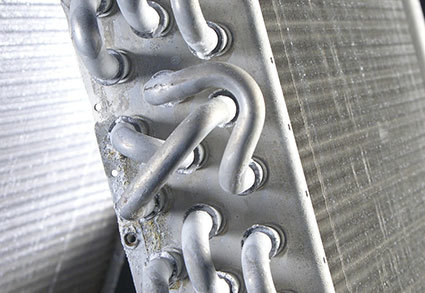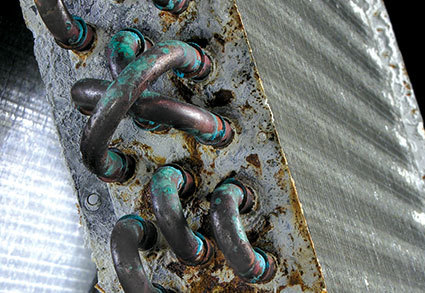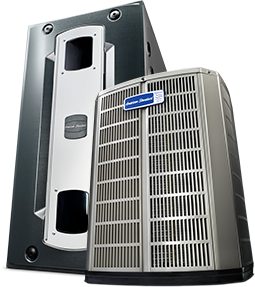Our Technology
Design & Innovation
Top to bottom, inside and out, our systems are meticulously engineered, relentlessly iterated, and constantly innovated to keep them at the forefront of the industry.
Duration® Compressors
With nearly a billion cycles a year in heat pump applications, no other part experiences as much simultaneous mechanical and thermal stress. That kind of durability doesn’t come off the shelf, so we build our own valves from a nearly indestructible blend of Swedish steel with a very high carbon content and very few sulfide and silicate occlusions. This special formula makes it extremely heat resistant, but also highly resistant to impact, distortion and metal fatigue.
Every part of a Duration compressor has been designed in some way to make it more efficient. That even includes the way we run our gas lines. Duration compressors route return suction gas over the motor to help prevent liquid refrigerant from reaching the valves and maintain motor temperature.
Meanwhile, discharge lines are routed down through the compressor sump for three reasons. First, the line and oil act as a vibration damper during startup and shutdown. Second, the heat from the discharge line vaporizes liquid refrigerant in the sump, separating it from the oil. Third, the oil dampens the motion of the discharge line during operation
But we don’t stop there. American Standard’s piston head is sculpted to provide minimum clearance at full upstroke to just a few ten-thousandths of an inch. Tighter tolerances mean more efficient compression, less wasted movement, higher volumetric efficiency and higher EER ratings.
Duration compressors are designed with two integrated safeguards that work in tandem to protect them from excessive stress and pressure. The Internal Overload device (IOL) shuts the compressor off automatically if it detects any combination of temperature and current outside of acceptable ranges. The Internal Pressure Relief valve (IPR), meanwhile, releases hot gas over the IOL when it detects a pressure difference of more than 400–500 psi between the discharge and suction sides, causing the IOL to shut the compressor down.
Duration compressors have a 25% larger shell than many of our competitors. Why? For starters, a larger shell volume provides a greater safety margin against refrigerant slugging and performance loss due to pressure drops. It also eliminates the need for suction line accumulators on residual units, which is better for many reasons. A system without an accumulator doesn’t suffer from reduced oil return. Removing the accumulator from the system also means one less place for a leak to occur and, thanks to Duration’s clever design, more fully vaporized liquid refrigerant.

Spine Fin
Optimized for heat transfer inside and out, the unique construction of a Spine Fin means it’s made in one continuous piece. The only brazed joints occur at the inlet and outlet; fewer brazed joints mean fewer chances for a leak to develop. As a result our Spine Fin coils are one of the most durable and reliable on the market.
Additionally, Spine Fin’s unique transition joint provides an ideal bond between the aluminum fin coils and the copper coils of the refrigerant circuit. The joint is ultrasonically tinned with a zinc-rich aluminum solder. As it comes in contact with the heated tubing, the joint forms a thin layer of solder between both base metals to resist bi-metallic corrosion.


All-Aluminum For A Reason

Since the inception of the home comfort industry, all manufacturers have faced the very real problem of formicary corrosion. This corrosion comes not from the build quality, but from copper’s natural tendency to absorb and bond with indoor contaminants in the air.
Rather than finding new ways to prevent formicary corrosion, American Standard simply eliminated the problem altogether by creating the industry’s first truly reliable, production-friendly aluminum indoor coil. With aluminum tubes, aluminum fins, aluminum tube sheets and aluminum end plates, it represents the leading edge of corrosion-resistant coil technology.
But don’t take our word for it …


The only finish good enough for American Standard also happens to be the best in the industry. It all starts with the way we apply it. Ultraviolet rays break down the chemical bonds in normal liquid paint, resulting in fading and chalking. So instead, we cover our cabinet louvers in powder paint, known for its resistance to the effects of UV light. Rather than painting or spraying, powder paint is affixed using electrostatic bonding, and baked in a superheated oven. This results in a more durable finish, but it also takes coverage more even; during the liquid painting process, surface tension causes paint to recede from the edges. Our powder-painting method actually causes an electrostatic charge to build around the edges, causing more paint to collect around these critical areas for greater resistance to corrosion and rust.
But we don’t stop at the paint. While other manufacturers are content to use mesh or wire guard to protect their coils, our standards demand more. Instead, American Standard uses full louvers made of heavy galvanized steel to protect our coils. Found on all 4 sides, these louvers provide superior protection from hail, lawn equipment and gardening implements.
The upshot? Our systems truly are designed to handle anything. Speaking of “anything”…
The Seet Laboratory
Our Systems Extreme Environmental Test (SEET) lab is more than a proving ground—it’s a gauntlet. Over the course of 16 weeks, test units undergo a two week regimen of brutal extremes, eight consecutive times.
They’re subjected to an environmental roller coaster far beyond anything they’d encounter in the real world. One day we’re cooking them in the heat and moisture of a Gulf Coast summer; the next, we’re icing them over in a simulated New York blizzard. All the while starting them up and shutting them down as abruptly as we can, 24 hours a day, every day, for (let’s say it again) sixteen straight weeks.
SEET vividly reflects our philosophy of testing in the lab, not a consumer’s home. It’s one of the most grueling test beds in the industry , and when it’s over—2,668 hours later—we’ve got proof our products truly are built to a higher standard.
Eight rounds of worst-case scenarios

Meet Snowball, The Compressor That Could
Underneath that frozen condensate sits a remarkable symbol of American Standard Heating & Air Conditioning quality. Meet Snowball. As part of our research into adverse conditions and durability, Snowball was put into a continuous flood-back test to see how long it would last before it failed. 27 years later, we finally got our answer. This incredible resilience demonstrated the Duration compressor’s reliability under adverse conditions like low indoor airflow or system overcharge. Now imagine how long it’ll last when it’s not fighting for its life.

